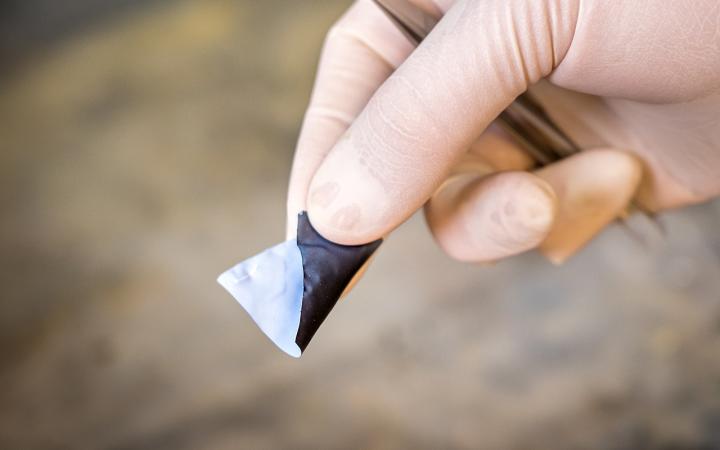'Spillway' for electrons could keep lithium metal batteries from catching fire

UC San Diego nanoengineers developed a separator that could make lithium metal batteries fail safely so that they do not rapidly overheat, catch fire or explode. Credit: David Baillot/UC San Diego Jacobs School of Engineering
The team made a clever tweak to the part of the battery called the separator, which serves as a barrier between the anode and cathode, so that it slows down the flow of energy (and thus heat) that builds up inside the battery when it short circuits.
The researchers, led by UC San Diego nanoengineering professor Ping Liu and his Ph.D. student Matthew Gonzalez, detail their work in a paper published in Advanced Materials.
“We're not trying to stop battery failure from happening. We're making it much safer so that when it does fail, the battery doesn't catastrophically catch on fire or explode,” said Gonzalez, who is the paper's first author.
Lithium metal batteries fail because of the growth of needle-like structures called dendrites on the anode after repeated charging. Over time, dendrites grow long enough to pierce through the separator and create a bridge between the anode and cathode, causing an internal short circuit. When that happens, the flow of electrons between the two electrodes gets out of control, causing the battery to instantly overheat and stop working.
The separator that the UC San Diego team developed essentially softens this blow. One side is covered by a thin, partially conductive web of carbon nanotubes that intercepts any dendrites that form. When a dendrite punctures the separator and hits this web, electrons now have a pathway through which they can slowly drain out rather than rush straight towards the cathode all at once.
Gonzalez compared the new battery separator to a spillway at a dam.
“When a dam starts to fail, a spillway is opened up to let some of the water trickle out in a controlled fashion so that when the dam does break and spill out, there's not a lot of water left to cause a flood,” he said. “That's the idea with our separator. We are draining out the charge much, much slower and prevent a 'flood' of electrons to the cathode. When a dendrite gets intercepted by the separator's conductive layer, the battery can begin to self-discharge so that when the battery does short, there's not enough energy left to be dangerous.”
Other battery research efforts focus on building separators out of materials that are strong enough to block dendrites from breaking through. But a problem with this approach is that it just prolongs the inevitable, Gonzalez said. These separators still need to have pores that let ions flow through in order for the battery to work. As a consequence, when the dendrites eventually make it through, the short circuit will be even worse.
Rather than block dendrites, the UC San Diego team sought to mitigate their effects.
In tests, lithium metal batteries equipped with the new separator showed signs of gradual failure over 20 to 30 cycles. Meanwhile, batteries with a normal (and slightly thicker) separator experienced abrupt failure in a single cycle.
“In a real use case scenario, you wouldn't have any advance warning that the battery is going to fail. It could be fine one second, then catch on fire or short out completely the next. It's unpredictable,” Gonzalez said. “But with our separator, you would get advance warning that the battery is getting a little bit worse, a little bit worse, a little bit worse, each time you charge it.”
While this study focused on lithium metal batteries, the researchers say the separator can also work in lithium ion and other battery chemistries. The team will be working on optimizing the separator for commercial use. A provisional patent has been filed by UC San Diego.
###
Paper title: “Draining Over Blocking: Nano-Composite Janus Separators for Mitigating Internal Shorting of Lithium Batteries.” Co-authors include Qizhang Yan, John Holoubek, Zhaohui Wu, Hongyao Zhou, Nicholas Patterson, Victoria Petrova and Haodong Liu, UC San Diego.
Media Contact
All latest news from the category: Power and Electrical Engineering
This topic covers issues related to energy generation, conversion, transportation and consumption and how the industry is addressing the challenge of energy efficiency in general.
innovations-report provides in-depth and informative reports and articles on subjects ranging from wind energy, fuel cell technology, solar energy, geothermal energy, petroleum, gas, nuclear engineering, alternative energy and energy efficiency to fusion, hydrogen and superconductor technologies.
Newest articles

NASA: Mystery of life’s handedness deepens
The mystery of why life uses molecules with specific orientations has deepened with a NASA-funded discovery that RNA — a key molecule thought to have potentially held the instructions for…

What are the effects of historic lithium mining on water quality?
Study reveals low levels of common contaminants but high levels of other elements in waters associated with an abandoned lithium mine. Lithium ore and mining waste from a historic lithium…

Quantum-inspired design boosts efficiency of heat-to-electricity conversion
Rice engineers take unconventional route to improving thermophotovoltaic systems. Researchers at Rice University have found a new way to improve a key element of thermophotovoltaic (TPV) systems, which convert heat…



